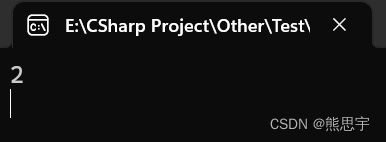C# List 详解五
目录
26.GetType()
27.IndexOf(T)
28.IndexOf(T, Int32)
29.IndexOf(T, Int32, Int32)
30.Insert(Int32, T)
31.InsertRange(Int32, IEnumerable)
32.LastIndexOf(T)
33.LastIndexOf(T, Int32)
34.LastIndexOf(T, Int32, Int32)
C# List 详解一
1.Add(T),2.AddRange(IEnumerable),3.AsReadOnly(),4.BinarySearch(T),
C# List 详解二
5.Clear(),6.Contains(T),7.ConvertAll(Converter),8.CopyTo(Int32, T[], Int32, Int32),9.CopyTo(T[]),10.CopyTo(T[], Int32)
C# List 详解三
11.Equals(Object),12.Exists(Predicate),13.Find(Predicate),14.FindAll(Predicate),15.FindIndex(Int32, Int32, Predicate),16.FindIndex(Int32, Predicate),17.FindIndex(Predicate)
C# List 详解四
18.FindLast(Predicate),19.FindLastIndex(Int32, Int32, Predicate),20.FindLastIndex(Int32, Predicate),21.FindLastIndex(Predicate),22.ForEach(Action),23.GetEnumerator(),24.GetHashCode(),25.GetRange(Int32, Int32)
C# List 详解五
26.GetType(),27.IndexOf(T),28.IndexOf(T, Int32),29.IndexOf(T, Int32, Int32),30.Insert(Int32, T),31.InsertRange(Int32, IEnumerable),32.LastIndexOf(T),33.LastIndexOf(T, Int32),34.LastIndexOf(T, Int32, Int32)
C# List 详解六
35.MemberwiseClone(),36.Remove(T),37.RemoveAll(Predicate),38.RemoveAt(Int32),39.RemoveRange(Int32, Int32),40.Reverse(),41.Reverse(Int32, Int32)
C# List 详解七
42.Sort(),43.ToArray(),44.ToString(),45.TrimExcess(),46.TrueForAll(Predicate)
C# List 详解一_熊思宇的博客-CSDN博客
C# List 详解二_熊思宇的博客-CSDN博客
C# List 详解三_熊思宇的博客-CSDN博客
C# List 详解四_熊思宇的博客-CSDN博客
C# List 详解六_熊思宇的博客-CSDN博客
C# List 详解七_熊思宇的博客-CSDN博客
26.GetType()
获取当前实例的 Type。(继承自 Object)
public Type GetType ();返回
Type
当前实例的准确运行时类型。
案例:
using System;
using System.Collections.Generic;
namespace ListTest
{
internal class Program
{
static void Main(string[] args)
{
List list1 = new List() { 1, 3, 5, 5, 6 };
Type type = list1.GetType();
Console.ReadKey();
}
}
} 27.IndexOf(T)
搜索指定的对象,并返回整个 List
public int IndexOf (T item);参数
item
T
要在 List
返回
Int32
如果找到,则为整个 item 中 List
案例:
using System;
using System.Collections.Generic;
namespace ListTest
{
internal class Program
{
static void Main(string[] args)
{
List list1 = new List() { 1, 3, 5, 5, 6 };
int value = list1.IndexOf(5);
Console.WriteLine(value);
Console.ReadKey();
}
}
} 运行:
28.IndexOf(T, Int32)
搜索指定对象并返回 List
public int IndexOf (T item, int index);参数
item
T
要在 List
index
Int32
从零开始的搜索的起始索引。 空列表中 0(零)为有效值。
返回
Int32
如果在 List
案例:
using System;
using System.Collections.Generic;
namespace ListTest
{
internal class Program
{
static void Main(string[] args)
{
List list1 = new List() { 1, 3, 5, 5, 6 };
int value = list1.IndexOf(5,3);
Console.WriteLine(value);
Console.ReadKey();
}
}
} 运行:
29.IndexOf(T, Int32, Int32)
搜索指定对象并返回 List
public int IndexOf (T item, int index, int count);参数
item
T
要在 List
index
Int32
从零开始的搜索的起始索引。 空列表中 0(零)为有效值。
count
Int32
要搜索的部分中的元素数。
返回
Int32
如果在 List
案例:
using System;
using System.Collections.Generic;
namespace ListTest
{
internal class Program
{
static void Main(string[] args)
{
List list1 = new List() { 1, 3, 5, 5, 6 };
int value = list1.IndexOf(5,3,2);
Console.WriteLine(value);
Console.ReadKey();
}
}
} 运行:
30.Insert(Int32, T)
将元素插入 List
public void Insert (int index, T item);参数
index
Int32
应插入 item 的从零开始的索引。
item
T
要插入的对象。 对于引用类型,该值可以为 null。
案例:
using System;
using System.Collections.Generic;
namespace ListTest
{
internal class Program
{
static void Main(string[] args)
{
List list1 = new List() { 1, 3, 5, 5, 6 };
list1.Insert(1, 2);
Console.WriteLine(string.Join("-", list1));
Console.ReadKey();
}
}
} 运行:
31.InsertRange(Int32, IEnumerable)
将集合中的元素插入 List
public void InsertRange (int index, System.Collections.Generic.IEnumerable collection); 参数
index
Int32
应在此处插入新元素的从零开始的索引。
collection
IEnumerable
应将其元素插入到 List
案例:
using System;
using System.Collections.Generic;
namespace ListTest
{
internal class Program
{
static void Main(string[] args)
{
string[] input = { "1", "2","3" };
List dinosaurs = new List();
dinosaurs.Add("a");
dinosaurs.Add("b");
dinosaurs.Add("c");
dinosaurs.InsertRange(2, input);
Console.WriteLine(string.Join("-", dinosaurs));
Console.ReadKey();
}
}
}
运行:
32.LastIndexOf(T)
搜索指定对象并返回整个 List
public int LastIndexOf (T item);参数
item
T
要在 List
返回
Int32
如果在整个 List
案例:
using System;
using System.Collections.Generic;
namespace ListTest
{
internal class Program
{
static void Main(string[] args)
{
List list1 = new List() { 1, 3, 5, 5, 6 };
int index = list1.LastIndexOf(5);
Console.WriteLine(index);
Console.ReadKey();
}
}
} 运行:
33.LastIndexOf(T, Int32)
搜索指定对象并返回 List
public int LastIndexOf (T item, int index);参数
item
T
要在 List
index
Int32
向后搜索的从零开始的起始索引。
返回
Int32
如果找到,则返回在 List
案例:
using System;
using System.Collections.Generic;
namespace ListTest
{
internal class Program
{
static void Main(string[] args)
{
List list1 = new List() { 1, 3, 5, 5, 6 };
int index = list1.LastIndexOf(5,2);
Console.WriteLine(index);
Console.ReadKey();
}
}
} 运行:
34.LastIndexOf(T, Int32, Int32)
搜索指定对象并返回 List
public int LastIndexOf (T item, int index, int count);参数
item
T
要在 List
index
Int32
向后搜索的从零开始的起始索引。
count
Int32
要搜索的部分中的元素数。
返回
Int32
如果在 List
案例:
using System;
using System.Collections.Generic;
namespace ListTest
{
internal class Program
{
static void Main(string[] args)
{
List list1 = new List() { 1, 3, 5, 5, 6 };
int index = list1.LastIndexOf(5,2,2);
Console.WriteLine(index);
Console.ReadKey();
}
}
} 运行:
第 5 / 7 篇 End







